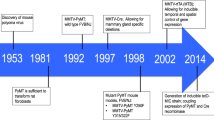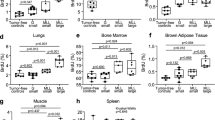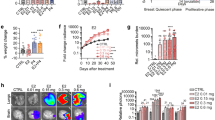Abstract
The 5′ flanking region of the C3(1) component of the rat prostate steroid binding protein (PSBP) has been used to successfully target the expression of the SV40 large T-antigen (Tag) to the epithelium of both the mammary and prostate glands resulting in models of mammary and prostate cancers which histologically resemble the human diseases. Atypia of the mammary ductal epithelium develops at about 8 weeks of age, progressing to mammary intraepithelial neoplasia (resembling human ductal carcinoma in situ [DCIS]) at about 12 weeks of age with the development of invasive carcinomas at about 16 weeks of age in 100% of female mice. The carcinomas share features to what has been classified in human breast cancer as infiltrating ductal carcinomas. All FVB/N female mice carrying the transgene develop mammary cancer with about a 15% incidence of lung metastases. Approximately 10% of older male mice develop anaplastic mammary carcinomas. Unlike many other transgenic models in which hormones and pregnancy are used to induce a mammary phenotype, C3(1)/Tag mice develop mammary tumors in the mammary epithelium of virgin animals without hormone supplementation or pregnancy. Although mammary tumor development appears hormone-responsive at early stages, invasive carcinomas are hormone-independent, which corresponds to the loss of estrogen receptor-α expression during tumor progression. Molecular and biologic factors related to mammary tumor progression can be studied in this model since lesions evolve over a predictable time course. Genomic alterations have been identified during tumor progression, including an amplification of the distal portion of chromosome 6 containing ki-ras and loss of heterozygosity (LOH) in other chromosomal regions. We have demonstrated that stage specific alterations in the expression of genes which are critical regulators of the cell cycle and apoptosis are functionally important in vivo. C3(1)/Tag mice appear useful for testing particular therapies since growth of the mammary tumors can be reduced using chemopreventive agents, cytokines, and an anti-angiogenesis agent.
This is a preview of subscription content, access via your institution
Access options
Subscribe to this journal
Receive 50 print issues and online access
$259.00 per year
only $5.18 per issue
Buy this article
- Purchase on Springer Link
- Instant access to full article PDF
Prices may be subject to local taxes which are calculated during checkout






Similar content being viewed by others
References
Allison J, Zhang YL and Parker MG. . 1989 Mol. Cell. Biol. 5: 2254–2257.
Amundadottir LT, Merlino G and Dickson RB. . 1996 Breast Cancer Res. Treat. 39: 119–135.
Carbone M, Fisher S, Powers A, Pass HI and Rizzo P. . 1999 J. Cell. Physiol. 180: 167–172.
Cardiff RD, Anver MR, Gusterson BA, Hennighausen L, Jensen RA, Merino MJ, Rehm S, Russo J, Tavassoli FA, Ward JM, Wakefield LM and Green JE. . (2000) Oncogene 19: 968–988.
Cato AC, Weinmann J, Mink S, Henderson D and Sonnenberg A. . 1989 J. Steroid Biochem. 34: 139–143.
Choi YW, Lee IC and Ross SR. . 1988 Mol. Cell. Biol. 8: 3382–3390.
Claessens F, Rushmere NK, Davies P, Celis L, Peeters B and Rombauts WA. . 1990 Mol. Cell. Endocrinol. 74: 203–212.
Cole CH. . 1998 Fields Virology, Vol. 2. Fiels BN., Knipe DM and Howley, PM. (eds).. Lippincott-Raven: Philadelphia pp 1997–2076.
Cox LA, Chen G and Lee EY. . 1994 Breast Cancer Res. Treat. 32: 19–38.
Dyson N, Buchkovich K, Whyte P and Harlow E. . 1989 Cell 58: 249–255.
Furth PA. . 1998 Dev. Biol. Stand. 94: 281–287.
Heyns W and DeMoor P. . 1977 Eur. J. Biochem. 15: 221–230.
Hodi FS and Dranoff G. . 1998 Surg. Oncol. Clin. N. Am. 7: 471–485.
Hurwitz AA, Yu TF, Leach DR and Allison JP. . 1998 Proc. Natl. Acad. Sci. USA 95: 10067–10071.
Liu M, Von Lintig F, Liyanage M, Shibata M, Jorcyk C, Ried T, Boss G and Green J. . 1998 Oncogene 17: 2403–2411.
Macleaod KF and Jacks T. . 1999 J. Pathol. 187: 43–60.
Maroulakou IG, Anver M, Garrett L and Green JE. . 1994 Proc. Natl. Acad. Sci., USA 91: 11236–11240.
Maroulakou IG, Shibata M-A, Anver M, Jorcyk CL, Liu M-L, Roche N, Roberts A, Tsarfaty I, Reseau J, Ward J and Green JE. . 1999 Oncogene in press.
Maroulakou IG, Shibata M-A, Jorcyk CL, Chen X-X and Green JE. . 1997 Mol. Carcinogen. 20: 168–174.
Martini F, Lazzarin L, Iaccheri L, Corallini A, Berosa M, Trabenaelli C, Calza N, Barbanti-Brodana G and Tongnon M. . 1998 Dev. Biol. Stand. 94: 55–56.
Merlino G. . 1994 Semin. Cancer Biol. 5: 13–20.
Mietz JA, Unger T, Huibregtse JM and Howley PM. . 1992 EMBO, J. 11: 5013–5020.
Moens U, Seternes OM, Johansen B and Rekvig OP. . 1997 Virus Genes 15: 135–154.
Parker MG, Webb P, Needham M, White R and Ham J. . 1987 J. Cell. Biochem. 35: 285–292.
Pittius CW, Sankaran L, Topper YJ and Hennighausen L. . 1988 Mol. Endocrinol. 2: 1027–1032.
Rushmere NK, Parker MG and Davies P. . 1987 Mol. Cell. Endocrinol. 51: 259–265.
Shibata M-A, Jorcyk CJ, Devor DE, Yoshidome K, Rulong S, Resau J, Roche N, Roberts AB, Ward JM and Green JE. . 1998a Carcinogenesis 19: 195–205.
Shibata M-A, Jorcyk CL, Liu M-L, Yoshidome K, Gold GL and Green JE. . 1998b Toxicol. Pathol. 26: 177–182.
Shibata M-A, Liu M-L, Knudson MC, Shibata E, Yoshidome K, Bandey T, Korsmeyer SJ and Green JE. . 1999 EMBO J 18: 2692–2701.
Shibata M-A, Maroulakou IG, Jorcyk CL, Gold LG, Ward JM and Green JE. . 1996a Cancer Res. 56: 2998–3003.
Shibata M-A, Ward JM, Devor DE, Liu M-L and Green JE. . 1996b Cancer Res. 56: 4894–4903.
Stamp G, Poulson R, Jamieson S, Smith R, Pertsers G and Dickson C. . 1992 Cell Growth Differ. 3: 929–938.
Tan J, Marschke KB, Ho K-C, Perry ST, Wilson EM and French FS. . 1992 J. Biol. Chem. 267: 4456–4466.
Tehranian A, Morris DW, Min BH, Bird DJ, Cardiff RD and Barry PA. . 1996 Am. J. Pathol. 149: 1177–1191.
Vanaken H, Claessens F, Vercaeren I, Heyns W, Peeters B and Rombauts W. . 1996 Mol. Cell. Endocrinol. 121: 1967–2205.
Voest EE, Kenyon BM, O'Reilly MS, Truitt G, D'Amato RJ and Folkman J. . 1995 J. Natl. Cancer Inst. 87: 581–586.
Watson M and Fleming T. . 1996 Cancer Res. 56: 860–865.
Yin C, Knudson CH, Korsmeyer SJ and Dyke TV. (1997).Nature 385: 637–640.
Zhang X, Chen MW, Ng A, Ng PY, Lee C, Rubin M, Olsson CA and Buttyan R. . 1997 Prostate 32: 16–26.
Acknowledgements
This project has been funded in part with Federal funds from the National Cancer Institute, NIH, under contract no. NO1-CO-56000.
Author information
Authors and Affiliations
Rights and permissions
About this article
Cite this article
Green, J., Shibata, MA., Yoshidome, K. et al. The C3(1)/SV40 T-antigen transgenic mouse model of mammary cancer: ductal epithelial cell targeting with multistage progression to carcinoma. Oncogene 19, 1020–1027 (2000). https://doi.org/10.1038/sj.onc.1203280
Published:
Issue Date:
DOI: https://doi.org/10.1038/sj.onc.1203280
Keywords
This article is cited by
-
Striking efficacy of a vaccine targeting TOP2A for triple-negative breast cancer immunoprevention
npj Precision Oncology (2023)
-
Is loss of p53 a driver of ductal carcinoma in situ progression?
British Journal of Cancer (2022)
-
Molecular signatures of in situ to invasive progression for basal-like breast cancers: An integrated mouse model and human DCIS study
npj Breast Cancer (2022)
-
Epithelial-mesenchymal plasticity determines estrogen receptor positive breast cancer dormancy and epithelial reconversion drives recurrence
Nature Communications (2022)
-
Efficacy of fluvastatin and aspirin for prevention of hormonally insensitive breast cancer
Breast Cancer Research and Treatment (2021)



